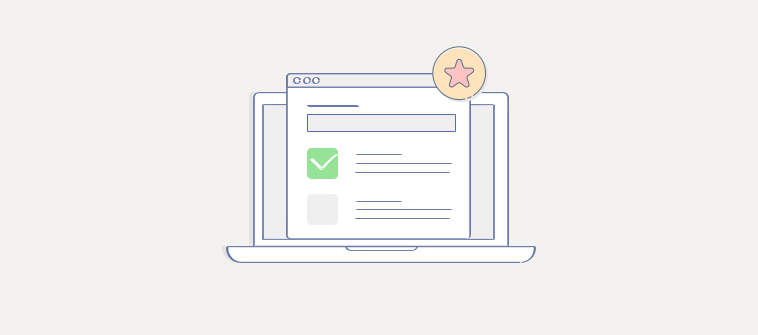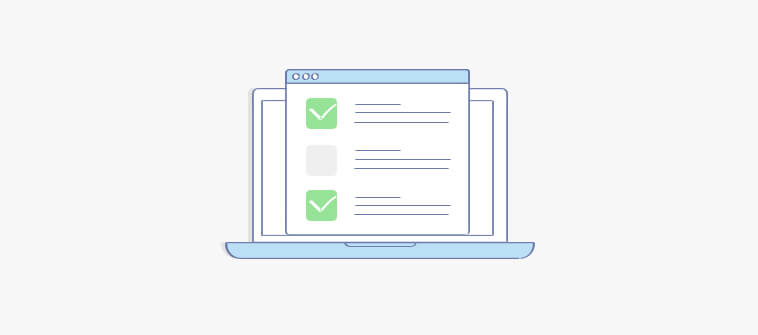You don’t need another long list of survey question types. You need a blueprint for the actual types of questionnaires and specifically, which ones can help you achieve your research goals.
Think of questionnaires as engines, not templates. Each one is built for a purpose: feedback, research, diagnosis, engagement. Get the engine wrong, and no amount of clever wording saves the data.
In this guide, we’ll cut straight to what works:
- The real types of questionnaires that founders, researchers, and people leaders use.
- When to deploy each (and when not to).
- How to scale them, from one-off feedback loops to reusable monthly trackers.
No fluff, just the mechanics that keep response rates high and insights sharp.
Let’s start with the basics first!
What Is a Questionnaire?

When you strip away the jargon, a questionnaire is just a way to collect answers without chasing people one by one. You send a set of questions to a group, they reply, and boom — you’ve got data you can actually use.
Think of it like a framework that helps you ask the same thing, the same way, every time. That’s what keeps the results consistent, whether you’re checking customer satisfaction, running an employee pulse, or testing a new product idea.
A questionnaire isn’t the same as a survey. The questionnaire is the tool; it holds the questions. The survey is the process. It handles distribution, collection, and analysis. Without a questionnaire, a survey has nothing to ask. Without a survey, a questionnaire just sits there collecting dust.
Sometimes, a questionnaire is as light as a one-liner: “How was your experience today?”
At other times, it’s a deep-dive, 20-question form designed to identify behavior patterns or track performance. What matters is that it matches your goal and respects your audience’s time.
Because if your respondents feel like your questionnaire is doing push-ups on their attention span… they’re not finishing it.
15 Types of Questionnaires You Should Know
Let’s keep this practical. Every questionnaire you’ll ever create fits into a few clear categories. Once you know which type you’re building, everything else—length, tone, and structure—falls into place.
I have differentiated all these types of questionnaires into 3 categories for your ease:
- Types Based on Purpose
- Types Based on Structure
- Types Based on Administration
Types Based on Purpose
Every questionnaire starts with a purpose. Some aim to measure satisfaction, others dig into research or track change over time. Knowing your purpose helps you decide what to ask, how deep to go, and how often to repeat it. Below are the most common questionnaire types based on intent
1. Feedback Questionnaires
Feedback questionnaires are the simplest but most powerful type. Their only goal is to collect immediate, actionable reactions while the experience is still fresh in the user’s mind. You’ll use them after purchases, classes, meetings, or support interactions — any touchpoint where emotion runs high and memory fades fast.
A good feedback questionnaire is concise, typically consisting of two to five questions. Start with a rating (1–5 or 1–10) to measure satisfaction, then follow up with an open “Why?” That combination gives you clean data and human context.
Timing is everything. Send it within minutes of the interaction. Automate it so no one forgets. Use this when you need a fast feedback loop, not a research study; it’s about fixing minor issues before they become big ones.
Here are ready-to-use customer and employee feedback questionnaire templates for you:
Customer Feedback Questionnaire:

Employee Feedback Questionnaire:
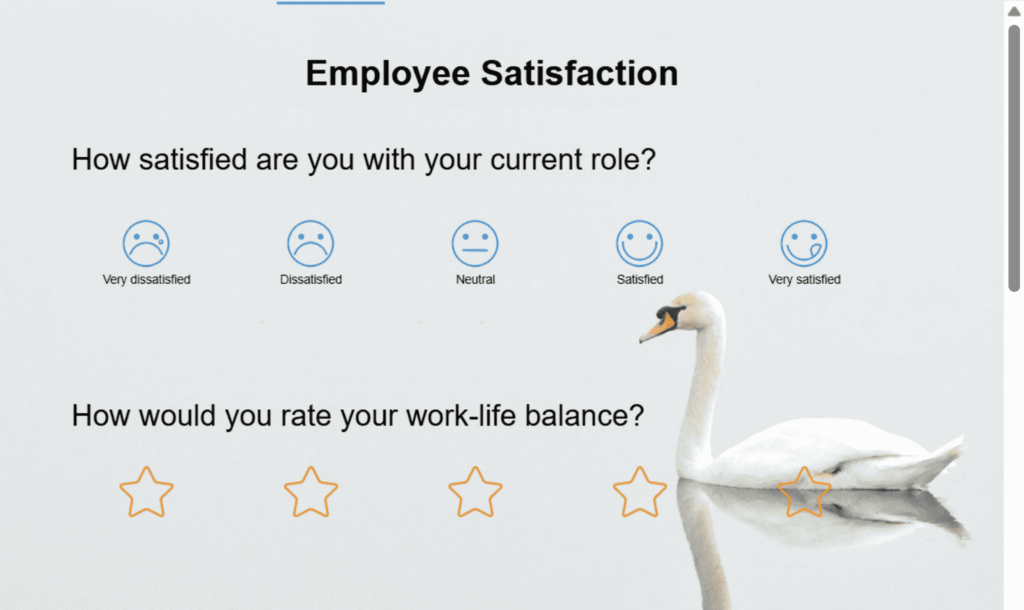
2. Research Questionnaires
Types of questionnaires in research are built for depth, accuracy, and comparability. Use them when you need hard data, not just opinions. They’re common in academic, market, and product research.
How They Work:
- Combine closed-ended questions (ratings, rankings) with a few open-ended ones for context.
- Group questions by theme: one idea per section.
- Test with 5–10 people before launch; pilot runs reveal confusion early.
Goal: Every type of survey questionnaire in quantitative research supports a single hypothesis. If it doesn’t, cut it. Once built well, a research questionnaire becomes a reusable tool. You can rerun it and benchmark results over time.
Here are a few research questionnaire templates you can use:
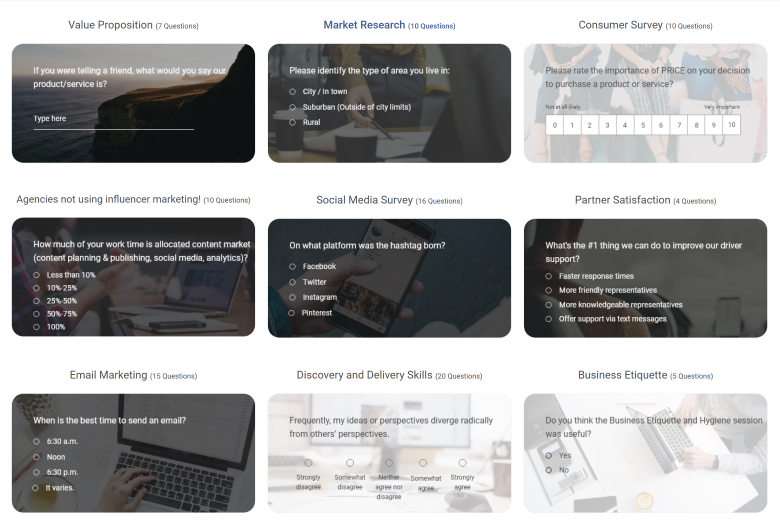
3. Diagnostic or Psychological Questionnaires
These uncover patterns in thinking, emotion, or behavior. You’ll see them in HR, therapy, coaching, and anywhere people need clarity about how they operate.
Structure:
- Use consistent rating scales (1–5 or Strongly Agree → Strongly Disagree).
- Keep phrasing neutral and precise.
- Start broad (“I enjoy solving problems”), then move to specifics (“I avoid tasks I find stressful”).
Best Practice: Clearly explain the purpose upfront so that people understand it’s about insight, not judgment. Analyze results across groups, not individuals, but patterns reveal more than one-off responses. Done right, these tools convert subjective feelings into data that you can actually use for informed decisions.
Here are a few employee psychology questionnaires that HRs can use to gauge employee emotions well:

4. Employee Questionnaires
Employee questionnaires are your internal truth serum. They reveal what people actually think about the company, the culture, and the work, not what they say in meetings. Use them for engagement checks, onboarding reviews, or exit insights.
How to Structure Them:
- 10–15 questions max. Keep language clear and bias-free.
- Mix rating scales (“I feel my work is recognized”) with one or two open prompts (“What’s one thing we could do better?”).
- Make anonymity real. Employees can sense fake promises instantly.
When to Use: Run short “pulse” versions monthly and full engagement surveys twice a year. Always share a “You said / We did” update after. The data means nothing if people don’t see action. In fact, you can try out this employee engagement template:

5. Educational Questionnaires
Educational questionnaires measure how learning actually lands. Teachers, trainers, and schools use them to assess course quality, teaching effectiveness, and student experience.
Keep It Simple:
- Start with scaled items: “The lessons were easy to follow.” (1–5 scale)
- Add one or two open questions: “What could make this course better?”
- Avoid academic jargon. Students respond better to plain language.
Execution Tips:
- Distribute right after class or course completion.
- Make responses anonymous to encourage honesty.
- Summarize results quickly and show what changed as a result of feedback.
Used regularly, these forms turn classroom feedback into clear data that improves teaching week after week. Here are a few educational questionnaires for teaching effectiveness and student feedback:

6. Healthcare Questionnaires
Healthcare questionnaires focus on clarity and sensitivity. Their goal is to gather information without overwhelming the patient. You’ll find them everywhere, from intake forms that capture medical history to post-care feedback surveys that assess satisfaction and outcomes.
Keep These Simple & Direct:
- Ask only what’s essential: symptoms, medication, or experience.
- Use plain, jargon-free language. Patients shouldn’t need a doctor to decode a question.
- Keep the length under five minutes; stress or fatigue shortens attention spans fast.
Execution Tips: Digitize the process where possible, but always keep a paper backup for inclusivity. Test readability with a small patient sample before rolling out the change. When used consistently, these forms create cleaner, more reliable patient data and stronger trust in care quality.
Want to try using one? Here’s a healthcare facility questionnaire for you:
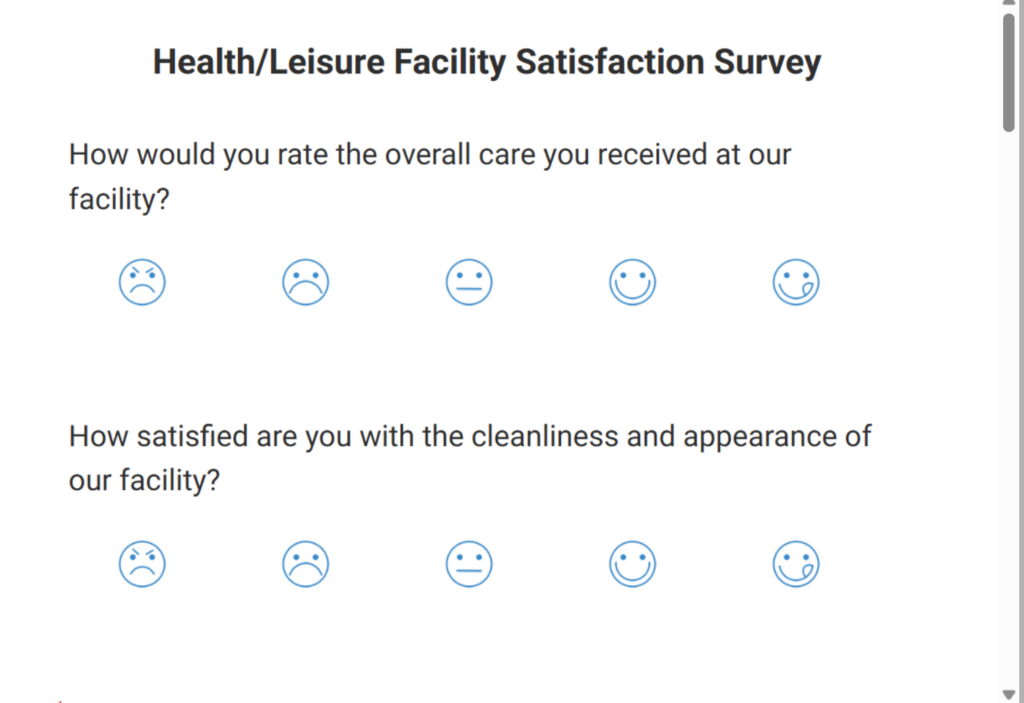
7. Market Research Questionnaires
Market research questionnaires dig into what people buy, why they buy it, and how they feel about it afterward. They’re used by marketers, founders, and product teams to test positioning before committing real spend.
How to Build Them:
- Start with segmentation questions, such as age, location, and purchase behavior.
- Add decision-making questions: “What matters most when choosing a product?”
- Mix multiple-choice (for patterns) with a few open questions (for motivation).
Best Practices: Keep surveys short, under 10 minutes. Focus on one theme per study (pricing, usability, or perception). Use diverse channels—email lists, social polls, or embedded forms—to reach balanced samples. When done right, this questionnaire saves months of guesswork and can validate or kill a bad idea before launch.
You can start out with this market research questionnaire template:
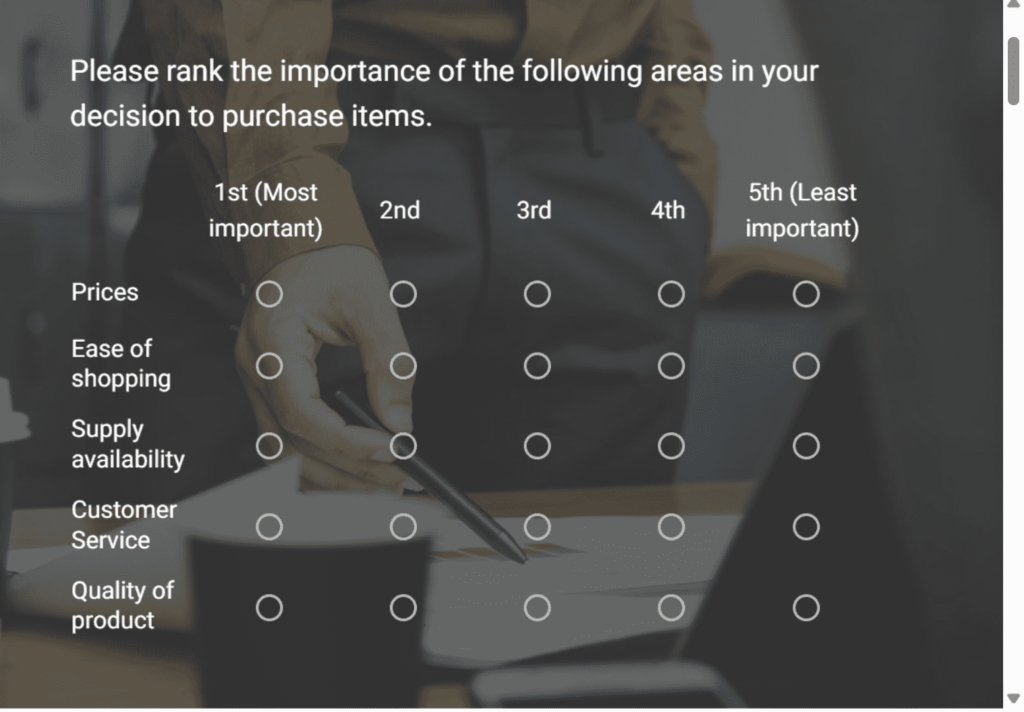
8. Longitudinal / Tracking Questionnaires
Longitudinal questionnaires are built for one thing: spotting change over time. You ask the same types of questions on questionnaires repeatedly (weekly, monthly, or quarterly) to track progress, sentiment, or results.
Where They Shine:
- Employee morale tracking.
- Therapy or coaching progress.
- Customer satisfaction trends.
How to Structure Them:
- Keep the questionnaire short (5–10 consistent items).
- Use identical phrasing every time — that’s what makes your comparisons valid.
- Automate delivery on a fixed schedule.
Avoid tweaking questions between runs; even small wording changes can skew trends. The payoff? You stop making one-off decisions and start seeing real movement — what’s improving, what’s stuck, and what’s sliding backward.
2. Types Based on Structure
Whether you’re designing a one-page form or a detailed survey with logic paths, structure defines both flow and engagement. These are the main types of survey questionnaires you’ll work with.
9. Detailed Questionnaires
Detailed questionnaires go beyond quick feedback — they’re designed for depth and decision-making. You’ll see them in HR evaluations, product research, and academic studies where surface-level answers won’t cut it.
How to Build Them:
- Organize questions by theme (satisfaction, usability, expectations).
- Use section headers so respondents don’t feel lost.
- Mix question types, like rating scales, multiple choice, and one or two open questions for context.
Expect longer completion times, so set clear expectations upfront (“Takes about 8 minutes”). Pilot-test every section; logic or order errors multiply fast in long forms. Used right, detailed questionnaires generate data deep enough to guide major product, policy, or research decisions, without overwhelming the participant.
10. Adaptive Questionnaires
Adaptive questionnaires are smarter versions of the standard form. They change in real time based on a respondent’s answers. Think of them as dynamic interviews — each answer reshapes the next question.
Why They Matter: They keep surveys relevant and short. Respondents only see questions that apply to them, ensuring high engagement and low frustration.
How To Set Them Up:
- Map out your logic first (“If yes → show A; if no → skip to B”).
- Use clear branching rules. Complexity should serve clarity, not show off.
- Test every path to avoid dead ends or loops.
They’re perfect for customer journeys, diagnostics, and eligibility forms where one-size-fits-all doesn’t work. Smart structure saves both your time and your respondents’ patience.

11. Simple Questionnaires
Simple questionnaires are your quick-response tools with no fluff or friction. You use them when you just need a pulse, not a full report. These are single-page forms that ask for a quick rating, a single choice, or a short comment. Think post-session feedback, checkout experiences, or quick internal reviews.
How to Use Them Effectively:
- Keep it under five questions.
- Stick to one goal and one audience.
- Use clear, simple language.
- Make sure it works on mobile since most responses come from phones.
Send it right after the event while attention is high. Simple questionnaires work because they respect people’s time. The faster someone can respond, the more honest their answers will be.
12. Reusable Questionnaires
Reusable questionnaires are built for consistency. You create them once and use them again and again for monthly employee checks, quarterly NPS surveys, or regular client feedback. Their strength lies in comparison. You are not just collecting data; you are tracking change.
How to Set Them Up:
- Keep the same questions each time to ensure clean trends.
- Automate scheduling so reminders are not forgotten.
- Store past responses and visualize progress clearly.
Avoid editing questions every round because even small wording changes can distort data. Reusable questionnaires give you a timeline of insights, not isolated snapshots. They are ideal for any team that wants to measure growth and improvement without having to reinvent the survey every time.
Here’s are two most common NPS templates you can use: Customer NPS and eNPS

3. Types Based on Administration
Questionnaires can reach people anywhere, like online, offline, or a mix of both. The correct delivery method depends on your audience, accessibility, and environment. Here’s how each administration type works and when to use it.
13. Online Questionnaires
Online questionnaires are the modern default. They’re fast to distribute, easy to automate, and simple to analyze. You’ll use them for customer feedback, employee engagement, or market research.
Setup Tips:
- Build in a browser-based tool that handles logic, scoring, and analytics automatically.
- Keep questions short and mobile-friendly.
- Use auto-save so partial responses are not lost.
- Embed the form on your website, email, or app for maximum reach.
Online questionnaires are scalable and cost-effective. The key is timing and clarity. Send them at the right moment and make every question easy to answer.
14. Offline Questionnaires
Offline questionnaires are still relevant when connectivity fails or respondents prefer personal interaction. Think healthcare clinics, field surveys, or remote locations.
Execution guidelines:
- Keep layouts simple for easy printing and manual data entry.
- Number questions for clarity.
- Leave enough white space for handwritten responses.
- Train collectors to stay neutral when reading questions aloud.
Once responses are collected, digitize them quickly for analysis. Offline questionnaires work best when you need accuracy from populations with limited digital access or want human interaction to increase trust.
15. Hybrid Questionnaires
Hybrid questionnaires blend online convenience with offline reliability. They’re common in organizations that need both reach and control, like universities, healthcare providers, and event teams.
How to Build Them:
- Start with a digital master version to ensure consistent wording.
- Provide printable copies or access via tablet for on-site collection.
- Sync all responses into one dashboard for unified reporting.
This setup ensures no data is lost, whether someone fills it out on paper or online. Hybrid questionnaires are ideal for large, diverse audiences, where some users are digital-first and others still prefer pen-and-paper methods.
How to Choose the Right Type of Questionnaire
Picking the right questionnaire isn’t guesswork. It’s about matching what you need to learn with how much effort you can ask from your audience. Here’s a straightforward way to do it.
Step 1: Define Your Goal
Ask yourself, “What do I need from this?”
- Quick reactions → Feedback questionnaire.
- Deep data → Research questionnaire.
- Ongoing tracking → Reusable or longitudinal questionnaire.
- Emotional or behavioral patterns → Diagnostic or psychological questionnaire.
Step 2: Know Your Audience
How much time will they realistically give you?
- Customers? Two minutes tops.
- Employees? Five to ten minutes if they trust you.
- Researchers or participants? Longer, if they see the value.
Step 3: Match the Structure
Simple for speed, detailed for depth, adaptive for relevance. If you’re unsure, start small. You can always scale a short form later.
Step 4: Choose Your Delivery Method
Online for reach. Offline for inclusivity. Hybrid if your audience spans both.
Step 5: Plan for Reuse
If this is something you’ll run again, like employee or customer tracking, lock your core questions now. That consistency turns feedback into real trends later.
The right questionnaire type saves you time twice: first when people actually complete it, and again when the insights make sense without a week of cleanup.
How to Create a Questionnaire That Works
You’ve seen what to avoid. Now, here’s how to build a questionnaire that actually gets results — from setup to launch.
1. Choose the Right Tool
Good questionnaires start with the right setup. Instead of building everything from scratch, use a tool that handles the structure for you, including question logic, templates, and analytics in one place.
ProProfs Survey Maker, for example, includes an AI Questionnaire Builder that can generate a working draft from a single prompt. You describe what you need, like “a course feedback form for online students,” and it instantly creates relevant questions and response types you can refine later. It’s designed to cut setup time without limiting control.
If you prefer visual guidance, there’s also a short tutorial video in the dashboard that walks through creating a questionnaire from scratch, from choosing templates to publishing and viewing responses:
2. Customize and Simplify
Refine your questionnaire to fit your audience.
- Keep questions relevant and short.
- Group similar topics together.
- Add your logo and color scheme for a polished, branded look. Here’s a video for you to brand your surveys effectively:
3. Test and Automate
Preview the questionnaire on desktop and mobile. Send a test run to your team or a small group. Once it’s solid, set up automated distribution through email, website embeds, or links. A good questionnaire maker tool handles scheduling and reminders so you don’t have to.
4. Analyze and Iterate
After responses come in, view results in real time. Built-in analytics dashboard visualizes trends and helps you identify patterns fast. Use those insights to refine future questionnaires — or duplicate the best-performing ones with a single click.
FREE. All Features. FOREVER!
Try our Forever FREE account with all premium features!
Best Practices for Designing Questionnaires
Most people design questionnaires like they’re building furniture from scratch—complicated, manual, and painful. The truth? Good design is about removing friction, not adding flair. Here’s how to do it well.
1. Design Backward From the Answer
Start with the decision you’re trying to make and work backward. What data do you need to make that call? Those are your questions. Anything that doesn’t serve that decision is clutter.
2. Make Layout Effortless
People don’t read questionnaires; they scan them. Group related items, use plenty of white space, and show visible progress. A clean layout beats a clever one every time.
3. Build for Mobile First
Most people answer on their phones. Test the design on a small screen before launch. If a question takes more than a scroll or two, simplify it.
4. Ask Less to Learn More
Every extra question costs attention. Keep only what you’ll actually use. A shorter, relevant questionnaire earns better completion and higher-quality data.
5. Close the Loop Every Time
Don’t end on “Submit.” End on “Here’s what happens next.” Show appreciation, set expectations, or share previous results if it’s a recurring form. A good close keeps people willing to answer again.
Good design isn’t about looks, it’s about flow. When people glide through your questionnaire, the data that comes back is cleaner, faster, and more useful.
Common Pitfalls That Ruin Good Questionnaires
Most bad questionnaires don’t fail because of bad intent. They fail because someone skipped the basics. Here are the common pitfalls that trip up even experienced teams, along with strategies to sidestep them.
| Pitfall | Why It Happens | How to Fix It |
|---|---|---|
| Starting Without a Goal | Teams jump into tools before defining the outcome. They collect answers with no clear decision to make. | Start with one question: “What will we do with this data?” If you can’t answer it, don’t start the questionnaire yet. |
| Asking Everything at Once | Fear of missing data leads to bloated forms that overwhelm respondents. | Focus on one objective per questionnaire. Run multiple small surveys instead of one monster form. |
| Overcomplicating the Design | Fancy layouts, sliders, or endless dropdowns look impressive but slow people down. | Use simple scales, clear choices, and predictable navigation. Less polish, more clarity. |
| Forgetting the Human Side | Designers treat respondents like data points, not people. | Explain why you’re asking, how long it’ll take, and what happens next. Human context drives completion. |
| Ignoring Response Fatigue | Constant surveys desensitize your audience until they stop engaging. | Limit frequency. Send questionnaires only at key moments where feedback truly matters. |
| Never Following Up | Teams collect responses but fail to close the loop. Participants feel ignored. | Share a quick summary: “Here’s what you said, here’s what we’re changing.” It builds trust and repeat participation. |
Why Understanding Questionnaire Types Matters
Most teams don’t fail because they ignore feedback; they fail because they collect the wrong kind of feedback. Choosing the right questionnaire type keeps your data clean, your insights sharp, and your respondents engaged.
Different goals demand different instruments. A five-question feedback form won’t replace a research study, and a 20-minute academic survey will kill customer responses. When you match the type to the purpose, everything works more smoothly: shorter forms, higher completion rates, clearer decisions.
Understanding questionnaire types also improves scalability. Once you’ve nailed the proper format for each goal, you can reuse, automate, and compare results over time. That’s how mature teams evolve their feedback systems. They stop reinventing surveys and start refining them.
Pick the Right Questionnaire Type & Get Started
Questionnaires aren’t just forms; they’re decision tools. When you understand the different types and how to use them with purpose, you stop chasing random feedback and start collecting data that actually changes things.
The best questionnaires don’t try to do everything. They focus on one goal, respect the respondent’s time, and deliver insights you can act on the same day. That’s what separates teams that measure from those that learn.
If you want a faster way to build, test, and reuse the right kind of questionnaire, start with a tool like ProProfs Survey Maker. Its AI-powered builder helps you launch in minutes, not hours. And, the templates are ready for every use case covered in this guide.
Frequently Asked Questions
What is the most popular questionnaire?
The feedback questionnaire remains the most widely used. It’s simple, short, and adaptable, used everywhere from customer service and education to healthcare and HR. NPS is often considered its most popular format because of its one-question simplicity.
What are the five common types of surveys?
The main five survey types are customer feedback, employee engagement, market research, academic or research, and product feedback surveys. Each has a distinct purpose, audience, and ideal question format.
How often should you run a questionnaire?
It depends on the goal. For feedback, send short questionnaires right after an experience. For engagement or tracking surveys, run them monthly or quarterly. The key is consistency and enough frequency to spot trends but not so often that people tune out.
Can questionnaires be reused across different audiences?
Yes, but with care. Keep the structure and logic the same for comparability, but adjust language and examples to match each audience’s context. For instance, a customer satisfaction form can easily become a student feedback form with minor wording changes.
FREE. All Features. FOREVER!
Try our Forever FREE account with all premium features!

 We'd love your feedback!
We'd love your feedback!
 Thanks for your feedback!
Thanks for your feedback!






